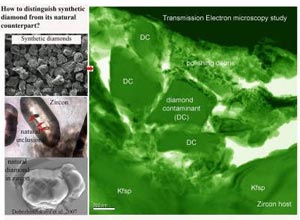Diamonds in Earth's oldest zircons are nothing but laboratory contamination

This image explains how synthetic diamond can be distinguished from natural diamond.<br><br>Credit: Dobrzhinetskaya Lab, UC Riverside.<br>
As is well known, the Earth is about 4.6 billion years old. No rocks exist, however, that are older than about 3.8 billion years. A sedimentary rock section in the Jack Hills of western Australia, more than 3 billion years old, contains within it zircons that were eroded from rocks as old as about 4.3 billion years, making these zircons, called Jack Hills zircons, the oldest recorded geological material on the planet.
In 2007 and 2008, two research papers reported in the journal Nature that a suite of zircons from the Jack Hills included diamonds, requiring a radical revision of early Earth history. The papers posited that the diamonds formed, somehow, before the oldest zircons — that is, before 4.3 billion years ago — and then were recycled repeatedly over a period of 1.2 billion years during which they were periodically incorporated into the zircons by an unidentified process.
Now a team of three researchers, two of whom are at the University of California, Riverside, has discovered using electron microscopy that the diamonds in question are not diamonds at all but broken fragments of a diamond-polishing compound that got embedded when the zircon specimen was prepared for analysis by the authors of the Nature papers.
“The diamonds are not indigenous to the zircons,” said Harry Green, a research geophysicist and a distinguished professor of the Graduate Division at UC Riverside, who was involved in the research. “They are contamination. This, combined with the lack of diamonds in any other samples of Jack Hills zircons, strongly suggests that there are no indigenous diamonds in the Jack Hills zircons.”
Study results appear online this week in the journal Earth and Planetary Science Letters.
“It occurred to us that a long-term history of diamond recycling with intermittent trapping into zircons would likely leave some sort of microstructural record at the interface between the diamonds and zircon,” said Larissa Dobrzhinetskaya, a professional researcher in the Department of Earth Sciences at UCR and the first author of the research paper. “We reasoned that high-resolution electron microscopy of the material should be able to distinguish whether the diamonds are indeed what they have been believed to be.”
Using an intensive search with high-resolution secondary-electron imaging and transmission electron microscopy, the research team confirmed the presence of diamonds in the Jack Hills zircon samples they examined but could readily identify them as broken fragments of diamond paste that the original authors had used to polish the zircons for examination. They also observed quartz, graphite, apatite, rutile, iron oxides, feldspars and other low-pressure minerals commonly included into zircon in granitic rocks.
“In other words, they are contamination from polishing with diamond paste that was mechanically injected into silicate inclusions during polishing” Green said.
The research was supported by a grant from the National Science Foundation.
Green and Dobrzhinetskaya were joined in the research by Richard Wirth at the Helmholtz Centre Potsdam, Germany.
Dobrzhinetskaya and Green planned the research project; Dobrzhinetskaya led the project; she and Wirth did the electron microscopy.
The University of California, Riverside is a doctoral research university, a living laboratory for groundbreaking exploration of issues critical to Inland Southern California, the state and communities around the world. Reflecting California's diverse culture, UCR's enrollment has exceeded 21,000 students. The campus opened a medical school in 2013 and has reached the heart of the Coachella Valley by way of the UCR Palm Desert Center. The campus has an annual statewide economic impact of more than $1 billion. A broadcast studio with fiber cable to the AT&T Hollywood hub is available for live or taped interviews. UCR also has ISDN for radio interviews. To learn more, call (951) UCR-NEWS.
Media Contact
More Information:
http://www.ucr.eduAll latest news from the category: Earth Sciences
Earth Sciences (also referred to as Geosciences), which deals with basic issues surrounding our planet, plays a vital role in the area of energy and raw materials supply.
Earth Sciences comprises subjects such as geology, geography, geological informatics, paleontology, mineralogy, petrography, crystallography, geophysics, geodesy, glaciology, cartography, photogrammetry, meteorology and seismology, early-warning systems, earthquake research and polar research.
Newest articles

Properties of new materials for microchips
… can now be measured well. Reseachers of Delft University of Technology demonstrated measuring performance properties of ultrathin silicon membranes. Making ever smaller and more powerful chips requires new ultrathin…

Floating solar’s potential
… to support sustainable development by addressing climate, water, and energy goals holistically. A new study published this week in Nature Energy raises the potential for floating solar photovoltaics (FPV)…

Skyrmions move at record speeds
… a step towards the computing of the future. An international research team led by scientists from the CNRS1 has discovered that the magnetic nanobubbles2 known as skyrmions can be…




















